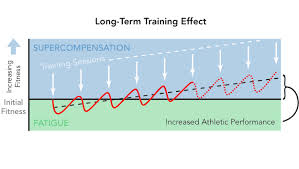In Part I of this two part piece, I summarized the muscular super compensation model, what it is, why it is important, how to interpret it, and provided some great visual pieces outlining how it functions. (If you haven’t read Part I I recommend doing so before going on to read this piece.)
Now that we understand the super compensation concept and why it is important, let’s apply it.
GETTING IT RIGHT
The crux of applying the super compensation model is this: To maximize our muscular and athletic development and minimize the risk of over training and injury, we want to time each of our workouts to match the peak of the super compensation phase from our last workout.
Lets take a look at a great visual aid I think really helps explain all this.

What we can see in this chart is that by timing our workouts to match the peak of the super compensation phase from our last workout we start our muscles’ next fatigue and recovery period from a new and higher level of ability. Over time, by consistently timing each workout to match the peak of the previous workout’s super compensation phase we can slowly but surely raise our muscles performance abilities.
Do you see the gap at the end of the graph between the solid line and dashed line labeled, “Increased Athletic Performance”? That is the difference between our muscles’ original abilities (before the first workout tracked by this graph) and their new abilities (after the last workout tracked by this graph.) That space is muscular represents our development!
GETTING IT WRONG
Now that we have established that we want to work out at the peak of our super compensation phase, lets look at the two most common ways we miss the super compensation peak and what happens if we miss it.
MISTAKE #1
The first, and an extremely common, way I see people miss working out at the peak of their muscles’ super compensation phase is by waiting too long to exercise again after their last workout. When we wait too long to exercise again our muscles’ temporarily improved abilities come back down and settle back to their pre workout level. This chart here showcases this effect.




